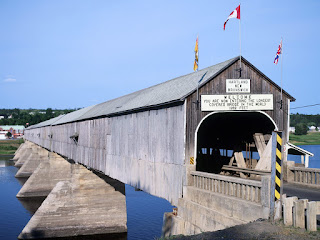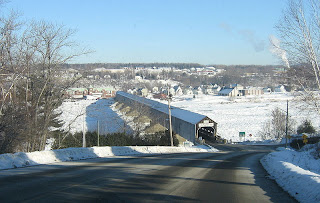It has the longest covered bridge in the world --
twelve hundred and eighty-two feet (390.75 metres)
of pine and spruce.
The bridge was built across the Saint John River in 1901
with major improvements in 1921 and 1945.
You can walk across this “wonder”
on its covered pedestrian walkway.
As a child, we traveled to Hartland
to visit Arthur and Hazel,
my great uncle and aunt.
They lived across the street
from Hatfield’s potato chip factory,
and we bought large brown bags
full of warm, freshly-made chips.
Hartland is located in Carleton County
about 10 miles from the USA
in New Brunswick
Only 1000 people live there,
but Hartland was home
to two recent New Brunswick
Hugh John Fleming (1952-1960)
and Richard Hatfield (1970-1987).
Weirdly, two American congressmen
were also born in Hartland:
Isaac Stephenson (Wisconsin, 1883-1889)
and Samuel Stephenson (Michigan, 1889-1897).
The town website is here.


These covered bridges - I've only every seen them before in Ohio when visiting an Aunt 25 years ago. Were they for snow? I don't think they exist in Europe at all, but I could be wrong.
ReplyDeleteHartland sounds like an interesting place. I checked out the link, and one theory about the origin of the name is that it was called after a Rev. Samuel Hart - a name that is of interest to me (see my Steinbeck's Redemtion blog 2 or 3 postings back).
The St. John's River - Is that the same as St. John's Newfoundland? I need a map! I have an old poem written by a Ballycarry fugitive of the 1798 rebellion, who fled to America in 1798. The poem is called "The Passengers", unfortunately it's 19 verses long, but the last few mention their arrival at the "banks of Newfoundland".
Hi Philip,
ReplyDeleteThe "Covered bridge" article at Wikipedia lists a number of covered bridges in Europe and Asia as well as America. It indicates that wooden bridges have a much longer lifespan if their structural members are protected from the elements.
Was your Samuel Hart an ancestor of your friend Alexander Hart?
The Saint John River arises in The Canadian Province of Quebec and in the U.S. state of Maine. It runs through New Brunswick into the Bay of Fundy. The city at its mouth is Saint John. This river and city never abbreviate "Saint" to "St."
The Newfoundland city of "St. John's" is one of North America's oldest, and "St." is always abbreviated, as far as I know.
Thanks Gary,
ReplyDeleteI checked out Wickopedia as you suggested and there were covered bridges in Europe (mostly Italy, Switzerland and Germany)- but the only one listed in Britain was one in Oxford that is a stone "Bridge of Sighs" type. I think we often underestimate the Germanic cultural influence in North America, as no doubt we do the French too.
I don't know about the Rev Samuel Hart of Hartland in New Brunswick - it would be nice to learn a bit more, but I couldn't "google" anything else (other than he was a Baptist minister).
I checked out St John's, Newfoundland and Saint John in New Brunswick on the "Google-earth" zoom, and now am enlightened.
It seems my Ballycarry adventurer was on a ship from Larne to Philadelphia (as he mentions passing Delaware and Newcastle, after the "banks of Newfoundland").
Was 1798 the Wolfe Tone rebellion?
ReplyDelete1798 rebellion? - yes, same one.
ReplyDelete